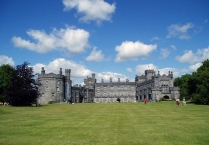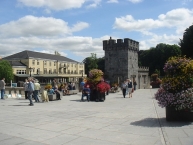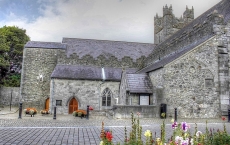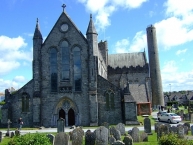Kilkenny
Worth visiting
Added on 19 Apr 2018,
last edited by biroto-Redaktion on 19 Apr 2018
Nearby cycle routes and tours
| Route name | Type | Dist. to route |
|---|---|---|
Tour | 0,3 km |
![]()
Please wait - map data are loading
Type of sights
Old town
Name and address
Kilkenny
IE-. Kilkenny
GEO-data
Geodetic coordinates
52.65∎∎∎∎ -7.25∎∎∎∎
Elevation
61 m
Communication
Information about copyright | |
|---|---|
Rights owner | https://commons.wikimedia.org/w/index.php?title=User:Tolivero~commonswiki |
Rights characteristic / license | by-sa: CREATIVE COMMONS Attribution-ShareAlike |
Link to the description of the license | |
Image taken over from | |
Image has been uploaded | by biroto-Redaktion on 19 Apr 2018
|
Information about copyright | |
|---|---|
Rights owner | https://commons.wikimedia.org/w/index.php?title=User:LikeThatWillHappen |
Rights characteristic / license | cc0: Public Domain no Rights reserved |
Link to the description of the license | |
Image taken over from | https://commons.wikimedia.org/wiki/File:Canal_Square_Kilkenny.JPG |
Image has been uploaded | by biroto-Redaktion on 19 Apr 2018
|
Information about copyright | |
|---|---|
Rights owner | |
Rights characteristic / license | by: CREATIVE COMMONS Attribution |
Link to the description of the license | |
Image taken over from | https://commons.wikimedia.org/wiki/File:Black_Abbey_(8239430612).jpg |
Image has been uploaded | by biroto-Redaktion on 19 Apr 2018
|
Information about copyright | |
|---|---|
Rights owner | |
Rights characteristic / license | cc0: Public Domain no Rights reserved |
Link to the description of the license | |
Image taken over from | https://commons.wikimedia.org/wiki/File:Kilkenny_St._Canice_Cathedral.jpg |
Image has been uploaded | by biroto-Redaktion on 19 Apr 2018
|
Kilkenny is a city in the 'Sunny South East' of Ireland. Ireland's mediaeval capital, it offers the traveller the mixture of a rich cultural heritage, beautiful streetscapes, an exciting vibrant nightlife and great shopping opportunities. The River Nore flows through the city, splitting it in two, with most sights of interest on the western side of the river. Kilkenny is the county town or main centre of County Kilkenny. With a population of 26,000, it's the size of a large town, but retains the official status of a city, a status granted it by King James I of England in 1609.
Understand
Kilkenny (Irish: Cill Chainnigh) is one of the most popular tourist destinations in Ireland as well as a weekend getaway for many Irish. Well regarded for its vibrant nightlife, it has become increasingly popular in recent years. The city is famous for its many mediaeval buildings and is referred to as the Marble City after the black polished limestone ['marble'] that was quarried around the city. The concept of a "Medieval Mile" has been instigated which endeavours to take in the majority of the city's iconic sights bookended by the Castle and St Canice's Cathedral respectively. Along the route, plaques have been put in place giving some historic background to the landmarks.
Despite its small population, it holds ancient city status due to having a cathedral and an old royal charter dating from 1609. The locals do not take kindly to the city being referred to as a "town". In the mid 1960s various arts and craft enterprises were set up in what was the stables for Kilkenny Castle. These still exist in various forms and in the county – particularly in Thomastown.
The city plays host to three festivals that bring large crowds from all over Ireland. In May the Rhythm and Roots music festival takes place in pubs and other venues around the city. On the June bank holiday weekend the Cat Laughs comedy festival take place. In August the Kilkenny Arts Festival, second only to its Galway equivalent, takes place. Venues for this last festival include the Castle and St Canice's Cathedral. The city centre is bookended by its two primary tourist attractions: St Canice's Cathedral to the north in Irishtown and Kilkenny Castle at the opposite end located on the Parade. The city has the greatest concentration of medieval churches in the country. On the occasion of the State purchasing St Mary's Hall, Ireland's paper of record, the Irish Times, stated that "St Mary's Hall in located halfway along the trail of the most significant medieval urban landscape in Ireland". All year round the coaches which line the Parade underline the popularity of Kilkenny as a tourist destination.
The lower end of the Parade, from the Castle to the traffic lights at the beginning of High Street, has recently been redesigned. It has created a pleasant pedestrian zone and also permits a nice vista of the Castle from High Street. It is the location of the only public toilets in the city. This new crude structure has had its appearance softened somewhat by the placing of tourist information boards across the front. These are well worth reading and will aid your enjoyment of the historic city. The tourist office, open all year round, is in Shee Alms House, on Rose Inn Street, five minutes walk from the Castle.
As a rule Kilkenny is a white collar city with one notable exception: Smithwicks, which was still brewed until recently at St Francis Brewery on Parliament Street. Glanbia, formerly Avonmore, a giant in food production, has its administration headquarters on the edge of the city having being founded twelve miles away in Ballyraggett, Co. Kilkenny. The main venue for performing arts is the art deco Watergate Theatre located between Parliament Street and Irishtown. The predominant sport in Kilkenny is hurling. Hurling is one of two codes in the Gaelic Athletic Association (GAA). Hurling is played with a wooden stick called a hurley. Using the hurley you hit a cork ball called a sliotar. Kilkenny as a county has won the most All-Ireland titles in the country. The local GAA stadium is Nowlan Park located ten minutes walk from the train station. The nickname for the team is the Cats. If Kilkenny are playing in the All-Ireland Final on the first Sunday of September, the city and county is decked out in the team colours of black and amber. It will be the talk of the town if they reach the Final. The Final is played in Croke Park, Dublin.
As a matter of curiosity, Kilkenny maybe the only place in Ireland with a street called The Parade. Only in Kilkenny and Dublin is there a Parliament Street.
Sightseeing, partying or a spot of shopping in Kilkenny's array of excellent shops, this city is certain to have it all for everyone.
History
Kilkenny has a long and interesting history. The city's origins pre-date the medieval landmarks existing today. Saint Canice founded a monastic settlement in Kilkenny in the sixth century. The sole remaining landmark from this settlement is the round tower beside St Canice's Cathedral. Strongbow, the famous Norman Conqueror, then built a fortress in the City, Kilkenny Castle, and soon the construction of the walled city began.
It wasn't until the seventeenth century that Kilkenny really entered its golden age. The parliament known as the Confederation of Kilkenny was founded in 1641. This, also known as Confederate Ireland, refers to the period of Irish self-government between the Rebellion of 1641 and the Cromwellian conquest of Ireland in 1649. One of the parliament's main objectives was to unite resistance against English persecution of Irish Catholics. With the emergence of this parliament, Kilkenny entered a period of unparalleled success. Over time, however, the influence of the Confederation of Kilkenny diminished. Oliver Cromwell's arrival in Kilkenny heralded the dissolution of the parliament, and the city never quite regained the prosperity it had been celebrated for.
See
Kilkenny City
Kilkenny City, Ireland's most beautiful historic city, is a perfect hub for arts and culture in Ireland. It is the historic gem in Ireland and the historic sites are concentrated in a small area in the City Centre. Many of the iconic city sights are located along the "Medieval Mile", which runs from The Parade (Kilkenny Castle & Design Centre), up High St (Tholsel, Hole in the Wall & Medieval Mile Museum), onto Parliament St (Rothe House & Smithwicks Brewery) and into Irishtown (St Canice's Cathedral).
- ⊙Kilkenny Castle and Gardens, The Parade, ☎ +353 56 7704100. Jun–Aug 09:00–17:30, other months 09:30 to between 16:30 and 17:30. This stunning Norman castle, which is the dominant feature in the town, is its principal attraction. It overlooks the River Nore. The Castle is three sided in shape. The oldest parts were built around the start of the 13th century. Inside, the Great Hall is very impressive. There is a beautiful rose garden to the front. Its huge forested gardens are beautiful to walk in during the day. There is a tea-room in it. Average visit lasts one hour. Adult €8. Free access to the grounds.
- ⊙Black Abbey, Abbey St. Founded in 1225, this impressive Dominican Abbey has beautiful stained glass windows and is itself surrounded by the old city walls. Near the Black Abbey, on Abbey Street, is Black Freren Gate, the last surviving gate of the city walls. Free admission.
- ⊙Rothe House & Garden, 15–16 Parliament St, ☎ +353 56 7722893. Apr–Oct M–Sa 10:30–17:00, Su 12:00-17:00; Nov–Mar M–Sa 10:30–16:30. A unique Tudor merchant's house built in the 16th century. It comprises three houses in the one complex. Behind the house lies a restored Tudor garden on a burgage plot – with resident Khaki Campbell domestic ducks. Rothe House contains Kilkenny Archeological Society's history museum and archive library. €5.50 Adults, €3 for groups (10+).
- ⊙St Canice's Cathedral & Round Tower, Coach Rd, Irishtown, ☎ +353 56 7764971. Jun–Aug M–Sa 09:00-18:00, Su 13:00-18:00 (08:00 Eucharist, 11:30 service). Built over 800 years ago in the 13th century, this impressive Cathedral and 9th-century round tower are one of Kilkenny's main attractions. It is the second largest medieval Cathedral in the country. Since the Protestant Reformation, it has belonged to the Church of Ireland (Anglican). With one of Ireland's only accessible round towers, on top of which one can see the most amazing view of Kilkenny, this is a must for anyone's trip to Kilkenny. The cathedral itself is wheelchair-accessible. Church & tower – adult €6.
- Grace's Courthouse, Parliament St (opposite Rothe House). Housing Kilkenny's Court House, this former fortress built in 1210 (Grace's Castle) and then converted into a prison in the 1500s is full of history.
- Butler House, Patrick St (across the street from the Castle, through the old stables). This stunning chateau-like building is one of the residences of the Butler family, who ruled Kilkenny for many years. It has a lovely small suburban garden. During Arts week in August it is used a venue for exhibitions.
- Kilkenny 'Slips'. These winding streets that ramble through the city, perpendicular to High St, are a true view of medieval Kilkenny.
- Smithwick's Experience Kilkenny, Parliament St, ☎ +353 56 7796498. 10:00-18:00 daily (last admission 17:00). This is Ireland's oldest brewery, founded in 1221. Kilkenny Beer, Smithwicks, and even Budweiser, have all been brewed here at some stage. Beer production ceased at the end of 2013. The Smithwick's Experience tour includes one pint at the end. Go early to get a ticket since there are only a few tours each day. Adult €13 (online €11.70), child €7.
- ⊙St. Mary's Cathedral, James St (just off High St). This is the Catholic Cathedral for the city, and was built by 1857. Its tower is visible around the city. It is a most impressive limestone structure.
- ⊙Tholsel, High St. This unique arcaded structure built in 1765 is the town hall. Look out for the city's coat of arms over the lowest arch. The Tholsel is in the middle of High St.
- Kilkenny Design Centre, Parade (opposite the Castle). This fabulous stone structure, spanning 19 windows in width and semi circle in form, was finished in 1800. The castle was the main house for the Butler family. This was the stables and through here you reached their town house, the aforementioned Butler House.
- St Kieran's College, College Rd (from the parade, head up Patrick St, turn right onto Ormonde Rd and then continue onto College Rd). This is a beautiful Gothic building of national significance completed in 1840. It was built as a boarding school and seminary. It is a famous hurling academy and in newer buildings still functions as a secondary school. The building is private but the grounds can be enjoyed.
- ⊙St John The Evangelist, Dublin Rd (opposite the train station). This is the finest parish church in the city. This large ornate Gothic Revival church was completed in 1908 and is curious for its flat-roofed main entrance flanked by two bays.
- ⊙St Canice's Church, Dean St, Irishtown. This Roman Catholic church has a lovely facade and was built by 1827.
- County Hall, John St. This fine seven-bay, three-storey Georgian building, built in 1782, houses the bulk of the county's administration offices. In a previous incarnation it was a college.
- ⊙Medieval Mile Museum, 2 St Mary's Ln (off High St). 10:00–18:00 (last admission 17:15). Located in the former St Mary's Church, built in 1205. The museum opened in Feb 2017. Allow 40 min to an hour to look around. Adult from €7.
- ⊙St John's Priory, cnr John St & Michael St (opposite Langtons). The Lady Chapel, built in 1290, was re-roofed and consecrated by the Church of Ireland in 1817. In the grounds are the ruins of the even older main chapel.
- The Hole in the Wall, off High St (opposite St. Mary's Lane). This quaint Elizabethan Tudor house dates from 1582 and features its own snug. It is a historically renowned tavern which has re-opened as a boutique arts venue. If it's open you will see a swing sign on High Street.
- Maudlin Tower, off Maudlin St (turn right at St John's Priory). This tall tower dates from the 15th century. There is no internal access but this tall tower is perfectly preserved externally and makes for fascinating viewing.
- ⊙St John's Priory, Lower New St (opposite the new tech secondary school). The restored sole remaining tower of the city walls. (updated Jun 2017)
Useful
Inside the range of 4 km:
- ⊙ Tourist-Information Kilkenny, Kilkenny
Information about copyright | |
|---|---|
Rights characteristic / license | by-sa: CREATIVE COMMONS Attribution-ShareAlike |
Link to the description of the license | |
Input taken over from: |
Wikivoyage contributors, 'Kilkenny', Wikivoyage, The FREE worldwide travel guide that anyone can edit, 24 January 2018, 05:33 UTC, <https://en.wikivoyage.org/w/index.php?title=Kilkenny&oldid=3386374> [accessed 19 April 2018] |
taken over / edited on | 19 Apr 2018
|
taken over / edited by |
|
Description of overnight bicycle parking:
. assumed
assumed
Nearby cycle routes and tours
| Route name | Type | Dist. to route |
|---|---|---|
Tour | 0,3 km |
Added on 19 Apr 2018,
last edited by biroto-Redaktion on 19 Apr 2018




